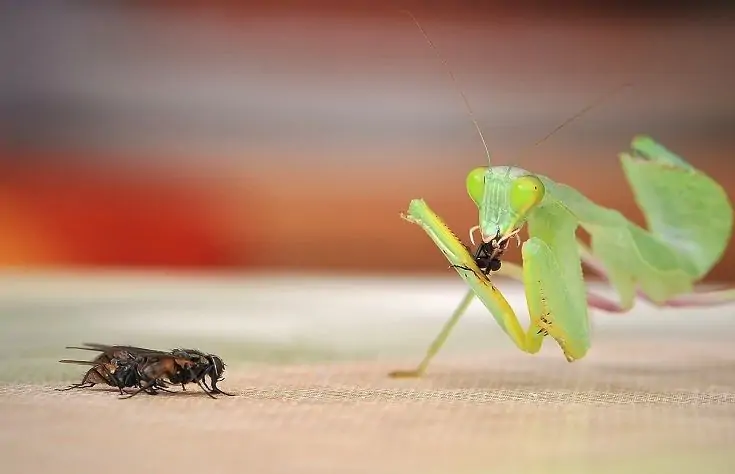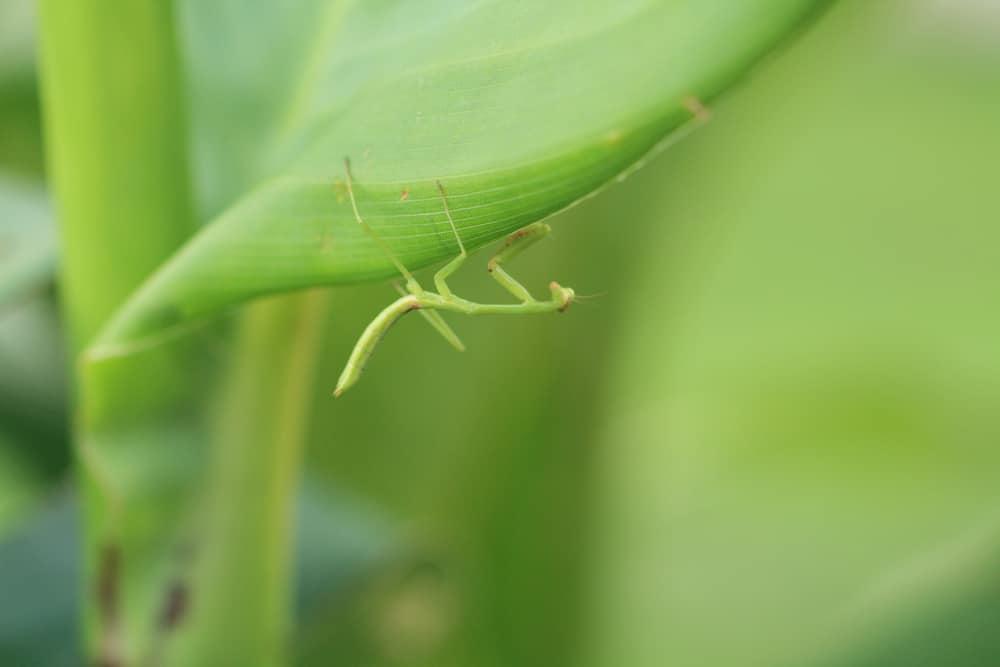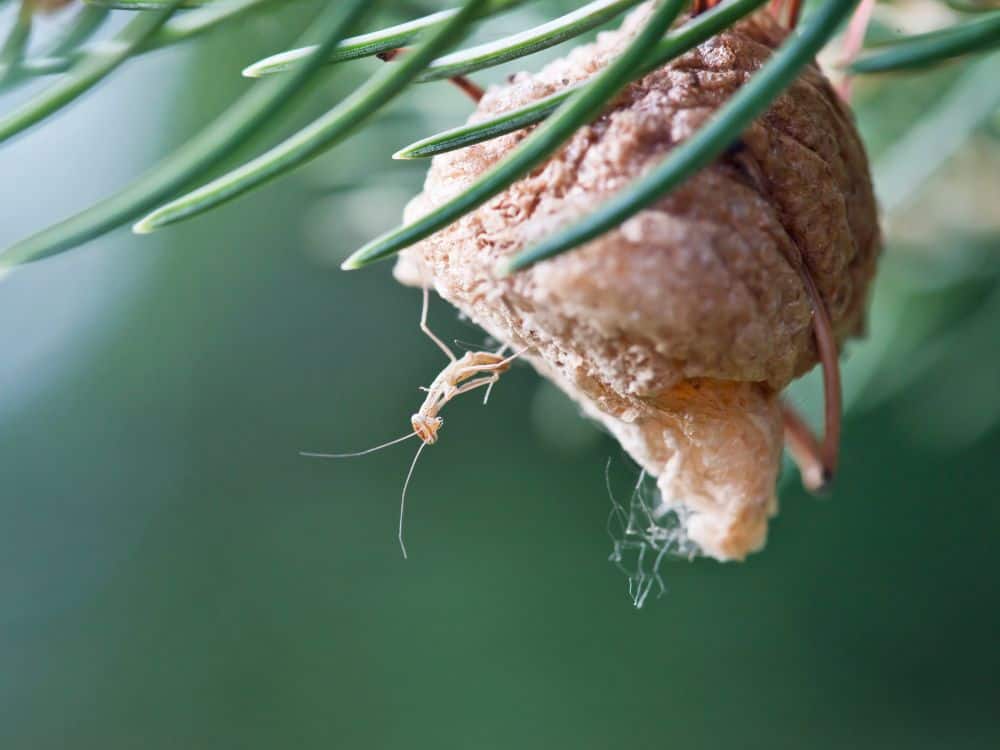A baby praying mantis is nowhere near its full-grown size once it hatches, but they have similar diets. Whether you’re curious about what wild baby mantises eat or trying to pin down a diet for your pet, there are plenty of answers.
For the most part, baby praying mantises eat smaller versions of the insects they eat as adults. They avoid more aggressive insects, like ants, bees, and wasps, and won’t attempt amphibians and reptiles until they’re fully armed for that combat.
This article explains what goes into the diet of baby mantises (in captivity and in the wild), how they feed, and how this diet evolves as they get older. We will also touch on other subjects, such as hydration.
Baby Praying Mantis Diet
A baby praying mantis’s diet changes depending on its size, what’s available, and whether they are in captivity or in the wild.
For the most part, it consists of:
- Other praying mantises
- Small insects (non-aggressive insects smaller than the baby mantis)
- Raw meat (in select cases)
Praying mantises are babies for a good portion of their life. They won’t be adults until they finish their final molt, and until then, they do not have the size, wings, or weapons needed to handle larger prey.
Diet in Eggs
When it’s still an egg, a baby mantid doesn’t need to worry about eating anything. It gets everything that it needs from the ootheca surrounding it, although the quality of the ootheca may be influenced by the mother mantis’s diet.
Other Praying Mantis Nymphs (Immediately After Hatching)
If they don’t find food within 24 hours of hatching, baby mantises will start to eat each other.
Cannibalism is not uncommon in mantids. In fact, their mating ritual ends with the female eating the head of the male and then his whole body.
If you’re keeping baby mantises in captivity, make sure you offer them adequate food soon after hatching to prevent this.
Small Insects (Most Common)

Once they hit the nymph stage, the most common food they eat will be tiny insects. The size and type differ depending on how large the praying mantis is.
Many start with tiny feeder insects, like fruit flies or aphids, before branching out to larger crickets or locusts.
The typical list includes:
- Young fruit flies
- Mealworms
- Aphids
- Pinhead crickets
- Locusts (appropriately sized)
- Houseflies
In the wild, this list expands to include mosquitoes and moths (neither of which you’re likely to find as feeders).
Young mantises tend to avoid any food that hides, including cockroaches and worms, even if they’re small enough to eat. As they get bigger (around one centimeter), they may no longer be attracted to smaller fruit flies or aphids.
Where to Get Small Insects for Baby Praying Mantis
If you’re feeding baby mantises in captivity, you may run into issues with finding insects small enough for them regularly. While they can go up to 4 days without food, waiting for a shipment of fruit flies to only find them too big to eat can be a major issue.
You should find a reputable local pet store that has a consistent supply of the insects you need. Ask them how often they have smaller insects, and make sure you scope out the stock before taking them at their word.
It’s even easier to feed baby mantises if you breed your own insects. Something as simple as setting up a fruit fly breeder can take care of your issue, and it prevents you from poaching flies from outside in a pinch.
Raw Meat (In Captivity)
While you can feed raw meat in captivity, it’s not recommended and not likely to succeed.
Raw meat can provide them with nutrition, but praying mantises are predators that prefer to hunt their prey. For this reason, they’re unlikely to eat unmoving or dead insects, and even flightless fruit flies may not move enough to attract them.
Raw meat may be okay in a pinch if your mantis will eat it, but eating too much can make them sick and it’s too far from their natural diet to provide adequate nutrition.
Feeding Baby Praying Mantises (In Captivity)
Now you know what baby praying mantis eat, it only makes sense to learn how to feed them.
This isn’t a major issue in the wild where it’s killing or be killed and survival of the fittest, but captive praying mantises rely on you for their care. You should understand how to present this food to them and what to look for to keep them as healthy as possible.
If you’re starting with a hatched mantis egg case, make sure you offer food as soon as they emerge. Choose the smallest prey option available (usually fruit flies or aphids) and offer enough for everyone to eat. Some recommend as many as fit in a test tube.
The smaller the feeder, the more you need to monitor for evasion. This is especially true if you rely on the mesh to keep them in the cage.
USDA approved hybrid wingless fruit flies are a great first food option because they will not repopulate in your home and a single culture can feed 20 mantids for up to a month. Tap anywhere from 4 to 12 into the enclosure every other day until the mantises outgrow them.
As they get bigger, they can eat larger prey, like pinhole crickets, and you won’t need to feed them as much. You should also take care not to feed them while they are molting, as the insects can harm them during this time.
Tips for Feeding Baby Praying Mantises
If your insects are too rambunctious for your baby mantis, try refrigerating them to slow them down. This is also helpful if you notice they’re wound up to attack your baby mantid.
Make sure every insect you release is consumed or removed from the enclosure. Watching for escapees ensures you don’t end up with loose bugs, but it also prevents your mantis from starving because the bugs are too evasive.
How a Praying Mantis Diet Evolves as They Age
As praying mantises get older, they usually eat the same prey but larger. Flightless fruit flies are replaced by houseflies, and aphids are booted in favor of grasshoppers and crickets.
Adult mantises are much larger and they have scythes and wings to help them hunt down their prey. At this point, they’ve honed their set of tools and skills to make them especially effective hunters.
Some larger mantises explore larger prey, including small reptiles, amphibians, and fish. These aren’t their first choice, but it’s not uncommon to see a praying mantis consume these creatures.
Do Baby Praying Mantis Need Water?
No praying mantis needs water, and if you’re keeping them as pets you should keep sitting water out of their enclosure.
Praying mantises get their moisture from the food that they eat. Setting up a bowl of water is more likely to drown them, their prey, or attract rogue bugs to the enclosure.
They do need humidity for molting, although the desired level differs depending on the species you have. To accomplish this, you can mist the sides of the enclosure or add a damp sponge.
How Long Can Praying Mantis Live Without Food?
In captivity, you shouldn’t let a grown mantis go any longer than 4 days without food. They may fast on their own, skipping a day or two, but should never be forced to go without.
Offering enough food is especially important when baby mantises are just getting the hang of eating. Without adequate food, they will start eating each other without remorse.
It’s estimated that wild praying mantises can survive up to 6 weeks without food, but this number changed depending on species and other circumstances. Like many other wild critters, mantises must adapt to the surrounding conditions.
You may see wild mantises gorge on more food than you ever thought they could eat, and this is another example of adapting to what’s available.
Can You Release a Hand-fed Praying Mantis?
Once you start hand feeding a baby praying mantis, you can no longer release it in the wild. Any baby praying mantises that get their start in captivity should live out the rest of their life with a competent caretaker.
While they may grow to have the same tools as their wild cousins, captive-fed praying mantises do not develop their skills to the level needed to survive in the wild. Hunting their prey in a controlled environment does not compare to hunting out in the open.
Beyond this, captive-fed mantises haven’t developed the fighting skills needed to make sure they won’t turn into food for bigger spiders, hornets, frogs, lizards, and snakes. Even adult mantises will struggle, and babies are highly unlikely to survive.
Conclusion
A baby praying mantis basically eats smaller versions of what it would as an adult. Flies shrink down to (often flightless) fruit flies, aphids become a staple, and baby crickets are a popular source of sustenance.
If you’re looking for food for your baby mantis pet, make sure you find a pet store or breeder who can provide what you need on the schedule you need it. Consider breeding your own feeders and avoid wild insects that may carry pesticides or poisonous pollen.
If you still have questions about baby praying mantis diets, let us know in the comments!

